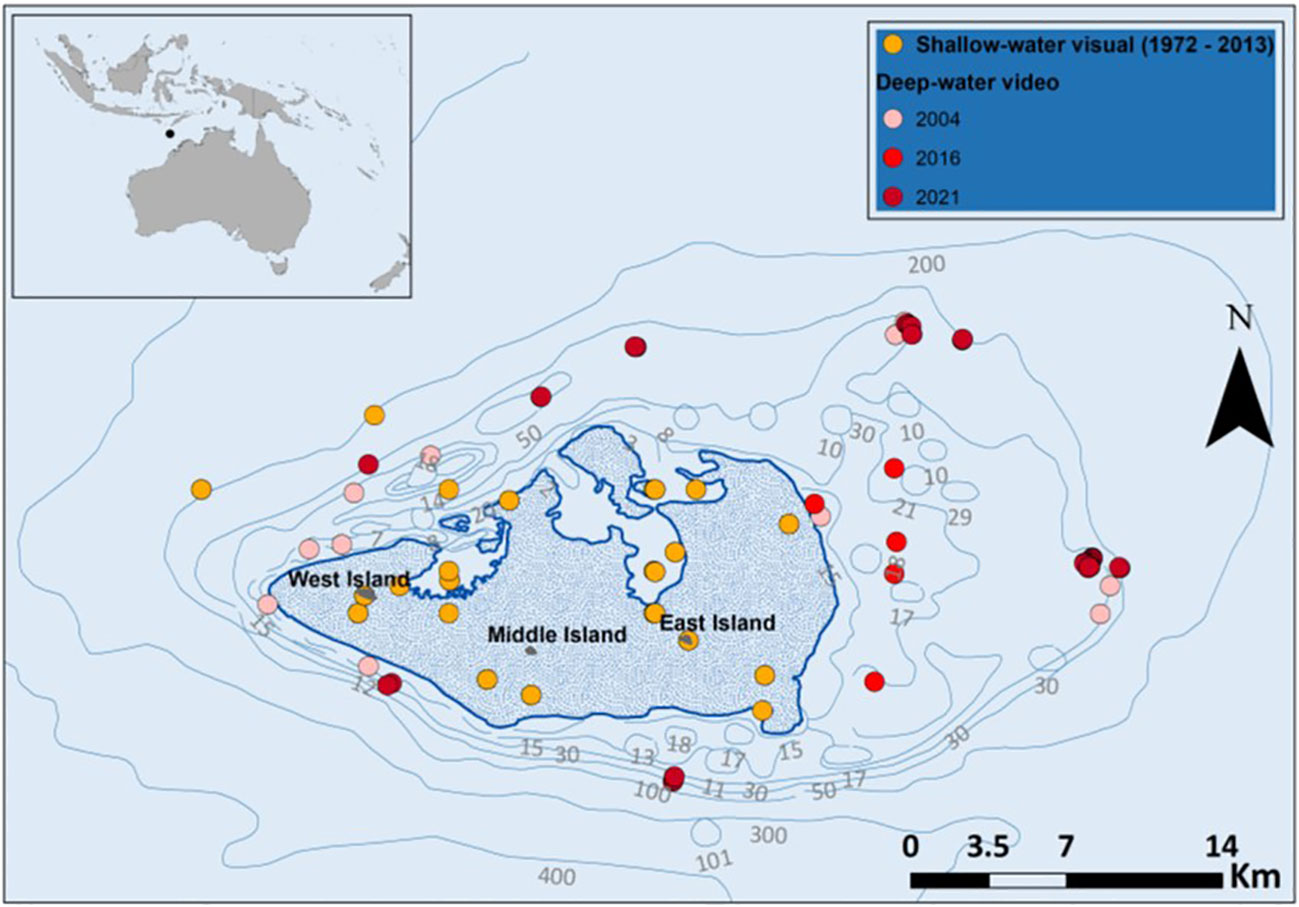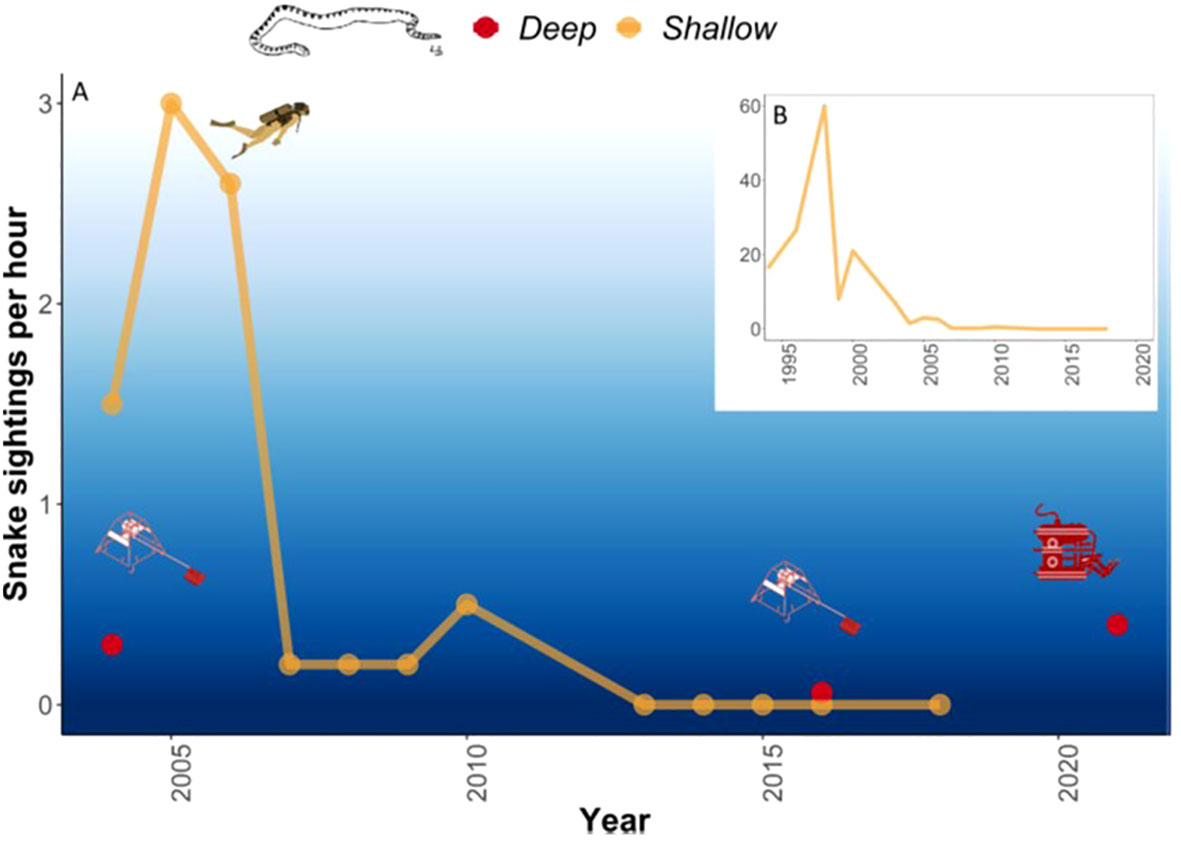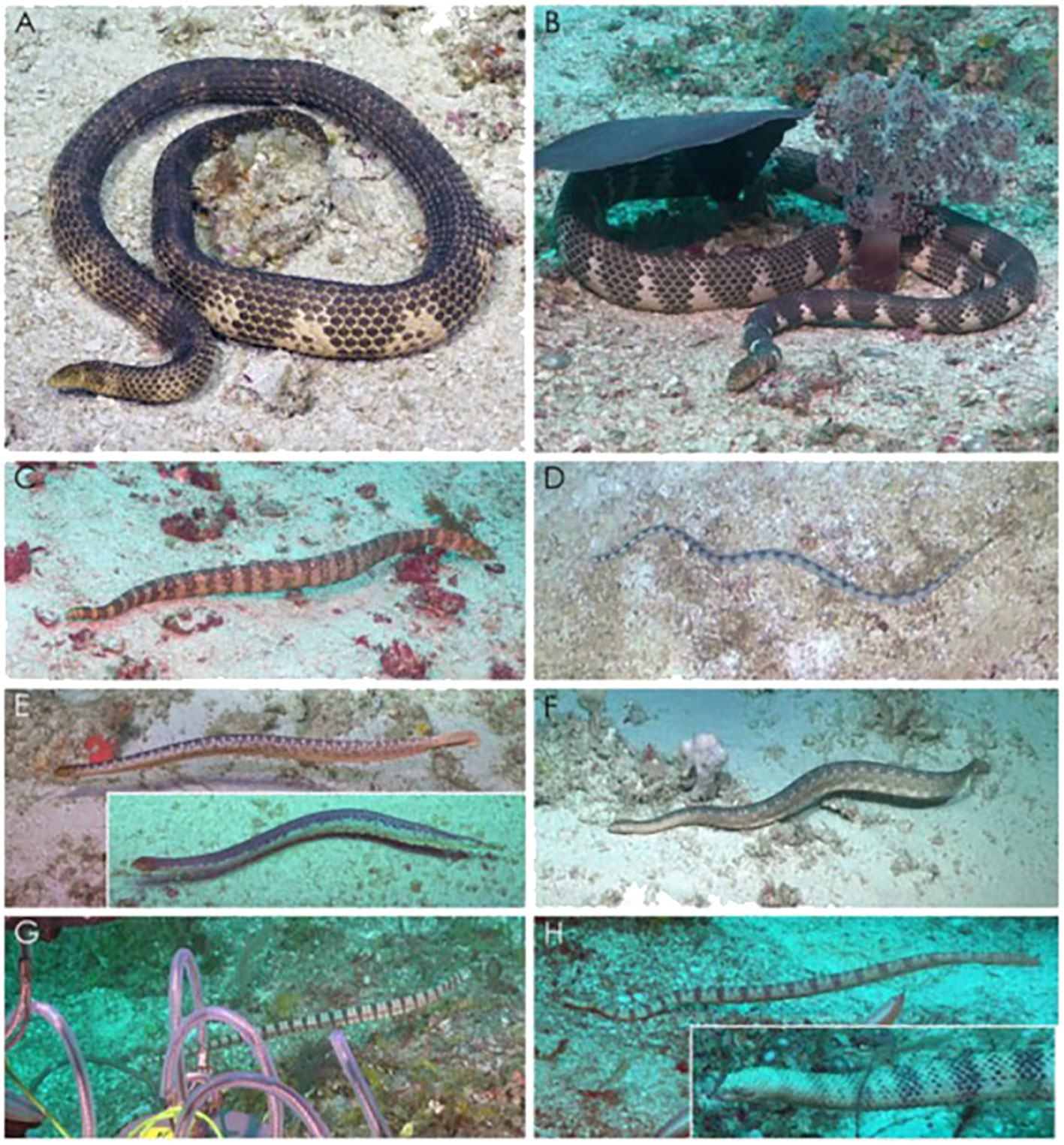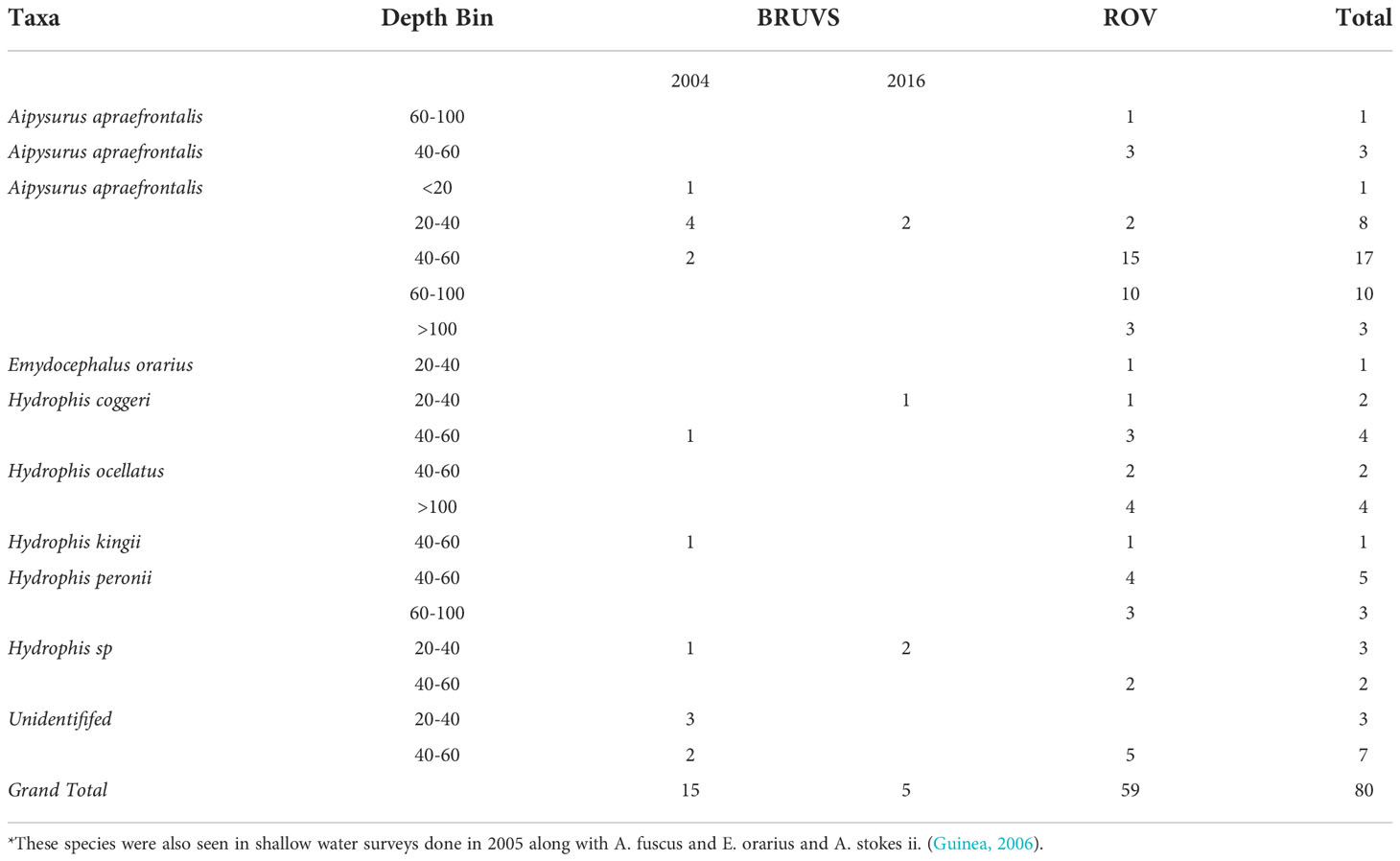- Research Institute for the Environment and Livelihoods, Charles Darwin University, Darwin, NT, Australia
A Commentary on
Video surveys of sea snakes in the mesophotic zone shed light on trends in populations.
By Speed CW, Wilson NG, Somaweera R, Udyawer V, Meekan MG, Whisson C and Miller K (2022) 9:921542. doi: 10.3389/fmars.2022.921542
The Ashmore Reef National Nature Reserve is an International Union for Conservation of Nature (IUCN) category 1a strict nature reserve with entry and fishing prohibited since 2002 (COA, 2002). Between 1999 and 2003, sea snakes on reef flats and channels suffered an unexplained rapid decline in numbers and species (Guinea et al., 2004). In those years as now, sea snake and shark populations appeared healthy at neighboring reefs (Somaweera et al., 2021). The Cartier Island Marine Reserve, 50 km to the east of Ashmore Reef, has identical zoning since 2002 (COA, 2002). The Hibernia Reef, 50 km north, is unmanaged. Being outside the Australian Provisional Fisheries Surveillance Enforcement Line (PFSEL) (COA, 2002), it has unrestricted fishing (Guinea, 2013).
This investigation focused on one hypothesis designated as plausible in Somaweera et al. (2021) to explain the disappearance of sea snakes from the Nature Reserve. It used the 2004 and 2016 recordings from Baited Remote Video Stations (BRUVS) (Speed et al., 2018) reexamined for the presence of sea snakes. A Remotely Operated Vehicle (ROV) recorded sea snakes in the mesophotic zone (50 –150 m) in 2021. These datasets suggested that shark sightings between 2004 to 2016 increased from 0.6 to 1.5/h in shallow water and 0.5 to 1.0/h in deeper water. The authors evaluated the hypothesis that increasing numbers of reef sharks led to the decline of sea snakes in shallow and deeper water habitats. The resultant correlation led to their acceptance of causation without performing a causality analysis. Concerns over their assumptions, presentations, and species identification question the veracity of the shark depredation hypothesis. David Hume (1739) established criteria for evaluating the cause and effect, which proves informative when investigating the cause of sea snake decline at Ashmore Reef. A critique using his rules of the present hypothesis follows:
(A) The agent of cause and the resultant effect need contiguity in time and space (met). Sharks, including gray reef sharks, Carcharhinus amblyrhynchos (Speed et al., 2018), and 11 sea snake species occured at Ashmore Reef (Minton and Heatwole, 1975).
(B) The cause must be prior to the effect (unmet). Sea snake species and numbers decreased rapidly between 1999 and 2003 (Guinea et al., 2004) and gradually thereafter (Somaweera et al., 2021). Gray reef shark numbers increased fourfold after suggested changes to enforcement in the Nature Reserve between 2008 and 2016 (Speed et al., 2018). Guinea (2020) strongly rejected any such change in enforcement. The hypothesized cause does not precede the effect. More recent data show that reef shark numbers remain unchanged at Ashmore Reef between 1998 and 2019 (Keesing et al., 2021).
(C) A constant relation must exist between the cause and the effect (unmet). Sharks, especially tiger sharks (Galeocerdo cuvier), are a major predator of sea snakes (Heatwole, 1975; Somaweera et al., 2021). Other species, including gray reef sharks, avoid eating sea snakes (Heatwole, 1975). Examples are missing in the literature of gray reef sharks eating sea snakes.
(D) The same cause always produces the same effect (unmet). The Cartier Island Marine Reserve, with the same strict zonation as Ashmore Reef, has both sharks and sea snakes in healthy numbers (Guinea, 2013). The Hibernia Reef, where fishing is unrestricted, has sharks and sea snakes present in good numbers also (Guinea, 2013).
(E) In a stable system, a cause is required to bring about an effect (unmet). Mentions in the literature of sea snakes from waters around Ashmore Reef persist from the mid-nineteenth century (Stokes, 1846), which suggests a continuing presence. Consistency persists in the species recorded by the ROV survey, which matches those of previous surveys to 25 m (Minton and Heatwole, 1975) and from the trawls to 100 m (Shuntov, 1971). The deep-water sea snake assemblage remains intact and appears unaffected by the cause of their decline in shallower water. The ROV dataset lacks reef shark observations, which precludes any analysis of the depredation hypothesis in the mesophotic zone.
The figures hinder our understanding by having shades of red data points on colored backgrounds (Figures 1, 2) . Further confusion stems from superimposed survey data points. Omitted is the boundary of the Nature Reserve, the site of all sea snake surveys since 1994 (Guinea, 2013). ROV transects are missing duration, lengths, and directions. Confusion continues in Figure 2 with glyphs on a colored background, and where four data points for 2004, 2006, 2014, and 2016 represent the two BRUVS surveys. Graphs with different scales in figures and supplementary material require scrutiny to avoid confusion. Notably, the exaggerated scales of sea snake sightings in Figure 2A overshadow the miniaturized Figure 2B showing the complete record.

Figure 1 Sea snake sightings in and around Ashmore Reef. The deep-water video surveys in 2004 and 2016 were done using BRUVS, whereas the 2021 survey used an ROV. Shallow-water visual survey data downloaded from Atlas of Living Australia; occurrence download at hitps://dol.ala.org.au/ dol/8685711-8ba7-40fe-a69c 6c4815145962;]sessionid=4A9BACF61447968564761E2739C05DBE, Accessed September 2021. Thick blue line denotes the reef edge and shaded area includes shallow coral Reef habitats. Reproduced from Speed et al. (2022).

Figure 2 (A) Sea snake sightings per hour at Ashmore Reef between 2004 and 2021. Deep-water video observations were made by BRUVS in 2004 and 2016 and ROV in 2021. (B) Historical shallow-water observations of sea snakes recorded per hour at Ashmore Reef since the 1994 (redravn from Somaweera et al., 2021). Diver image courtesy of the Integration and Application Network, University of Maryland Center for Environmental Science (lan.umces.ado/symbols/). Reproduced from Speed et al. (2022).
Other issues include misidentification of species. The turtle-headed sea snake at Ashmore Reef is Emydocephalus annulatus not E. orarius, a Western Australian coastal endemic (Nankivell et al., 2020). The sea snake labeled Hydrophis kingii in Figure 3 lacks the dark rhombic bands, the black head, and white scales around the eyes that are diagnostic for this species. Mentioned, but not explained, are differences in deep and shallow water forms of Aipysurus apraefrontalis. The statement that ROVs “caused undetectable or very minimal disturbance to the behavior of sea snakes” requires validation as the highly inquisitive species Aipysurus laevis makes 50% of sightings (Table 1 after corrections). Sounds and lights of the ROV will attract some species because light trapping is a standard technique for catching sea snakes (Guinea, 2013) and underwater noise such as hammering and drilling commonly attract sea snakes.

Figure 3 Photographs of sea snakes obtained during the ROV survey at Ashore Reef in 2021. (A) Aipysurus apraefrontalis, (B) Aipysurus duboisi, (C) Emydocephalus orarius, (D) Hydrophis coggeri, (E) Aipysurus laevis (colour variations), (F) Hydrophis ocellatus, (G) Hydrophis kingii, and (H) Hydrophis peroni (with closeup of head). Reproduced from Speed et al. (2022).

Table 1 Sea snake taxa identified at Ashmore reef using BRUVS survey in 2004 and 2016, a ROV survey in 2021.
The authors presented the necessary results to evaluate if predation by sharks could explain the decline in sea snakes in the Nature Reserve. Logic and field studies provide little support for such a hypothesis, which, when scrutinized, is implausible. Following this demotion, other putative causes require testing. The ROV survey showed that the deeper water sea snake assemblage remains stable, and the decline affected those living on the reef crest and channels. For researchers, the challenge remains of preventing sea snake declines on other reefs while monitoring their recolonization of Ashmore Reef National Nature Reserve.
Author contributions
The author is the contributor to this commentary Ms D'Anastasi requested to not be listed as a contributor, but mentioned only in the acknowledgments.
Funding
I am a retired researcher with the honorary status of Adjunct Research Fellow at Charles Darwin University, which by external contracts to government departments and industry bodies facilitated the fieldwork on which these comments are based.
Acknowledgments
The information provided in this commentary came from three decades of research while employed at Charles Darwin University and numerous trips to the reefs of the Sahul Shelf including Ashmore Reef for which I am grateful. I am grateful for constructive comments on an earlier draft of this commentary by a reviewer and Blanche D’Anastasi.
Conflict of interest
The author declares that the research was conducted in the absence of any commercial or financial relationships that could be construed as a potential conflict of interest.
Publisher’s note
All claims expressed in this article are solely those of the authors and do not necessarily represent those of their affiliated organizations, or those of the publisher, the editors and the reviewers. Any product that may be evaluated in this article, or claim that may be made by its manufacturer, is not guaranteed or endorsed by the publisher.
References
Commonwealth of Australia (2002). Ashmore reef national nature reserve and Cartier island marine reserve (Commonwealth waters) management plans (Canberra: Environment Australia).
Guinea M. (2005). Sea Snakes of ashmore reef, Hibernia reef and Cartier island. DEWHA Final Rep. Survey. 2005, 1–37.
Guinea M. L. (2013). Surveys of the sea snakes and sea turtles on reefs of the sahul shelf, monitoring program for the montara well release timor Sea (Darwin, NT: Charles Darwin University).
Guinea M. L. (2020). Comments on “Evidence for rapid recovery of shark populations within a coral reef marine protected area”. Speed etal. 2018(220), 308–319. doi: 10.1016/j.biocon.2020.108457
Guinea M. L., Koch A., Whiting S., Heatwole H., Palianappan P. (2004). “Annual report to DEH on research of sea snakes and sea turtles at ashmore reef,” in Permit number: M2003/0004 (Darwin, Northern Territory: Charles Darwin University).
Heatwole H. (1975). “Predation on sea snakes,” in The biology of Sea snakes. Ed. Dunson W. A. (Baltimore, MY: University Park Press), 233–249.
Hume D. (1739). “A treatise of human nature, being an attempt to introduce the experimental method of reasoning into moral subjects and dialogues,” in Edited, with preliminary dissertation and notes, vol. 1874 . Eds. Green T. H., Grose T. H. (London: Longmans Green & Co).
Keesing J. K., Webber B. L., Hardiman L. K. (2021). “Ashmore reef marine park environmental assessment,” in Final report to parks Australia (Crawley: CSIRO).
Minton S. A., Heatwole H. (1975). “Sea Snakes from three reefs of the sahul shelf,” in The biology of Sea snakes. Ed. Dunson W. A. (Baltimore, MY: University Park Press), 141–149.
Nankivell J. H., Goiran C., Hourston M., Shine R., Rasmussen A. R., Thomson V. A., et al. (2020). A new species of turtle-headed sea snake (Emydocephalus: Elapidae) endemic to Western Australia. Zootaxa 4758 (1), 141–156. doi: 10.11646/zootaxa.4758.1.6
Somaweera R., Udyawer V., Guinea M. L., Ceccarelli D. M., Clarke R. H., Glover M., et al. (2021). Pinpointing drivers of extirpation in sea snakes: a synthesis of evidence from ashmore reef. Front. Mar. Sci. 8. doi: 10.3389/fmars.2021.658756
Speed C. W., Cappo M., Meekan M. G. (2018). Evidence for rapid recovery of shark populations within a coral reef marine protected area. Biol. Conserv. 220, 308–319. doi: 10.1016/j.biocon.2018.01.010
Speed C. W., Wilson N. G., Somaweera R., Udyawer V., Meekan M. G., Whisson C., Miller K. (2022). Video surveys of sea snakes in the mesophotic zone shed light on trends in populations. Front. Mar. Sci. 9, 921542–319. doi: 10.3389/fmars.2022.921542
Keywords: Ashmore Reef, sea snakes, sharks, ROV, BRUVs, Aipysurus, Hydrophis
Citation: Guinea ML (2022) Commentary: Video surveys of sea snakes in the mesophotic shed light on trends in populations. Front. Mar. Sci. 9:1084979. doi: 10.3389/fmars.2022.1084979
Received: 31 October 2022; Accepted: 28 November 2022;
Published: 22 December 2022.
Edited by:
Angel Borja, Technology Center Expert in Marine and Food Innovation (AZTI), SpainReviewed by:
Neville Scott Barrett, University of Tasmania, AustraliaCopyright © 2022 Guinea. This is an open-access article distributed under the terms of the Creative Commons Attribution License (CC BY). The use, distribution or reproduction in other forums is permitted, provided the original author(s) and the copyright owner(s) are credited and that the original publication in this journal is cited, in accordance with accepted academic practice. No use, distribution or reproduction is permitted which does not comply with these terms.
*Correspondence: Michael L. Guinea, bWlja19ndWluZWFAYmlncG9uZC5jb20=
 Michael L. Guinea
Michael L. Guinea